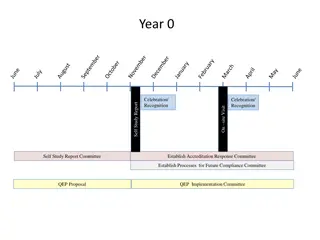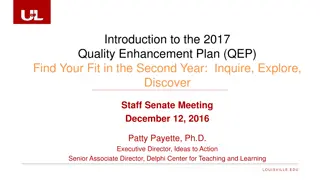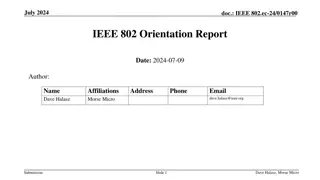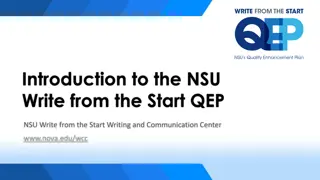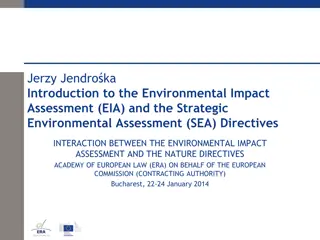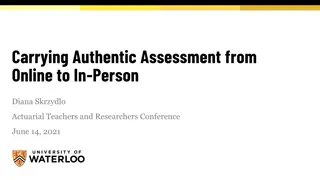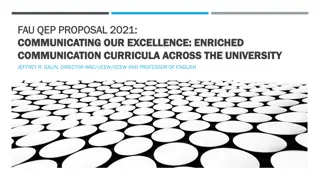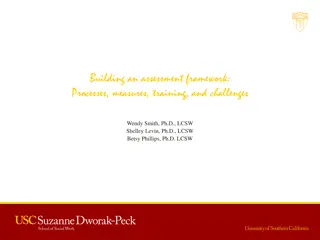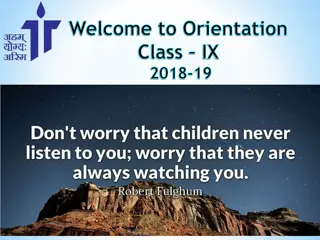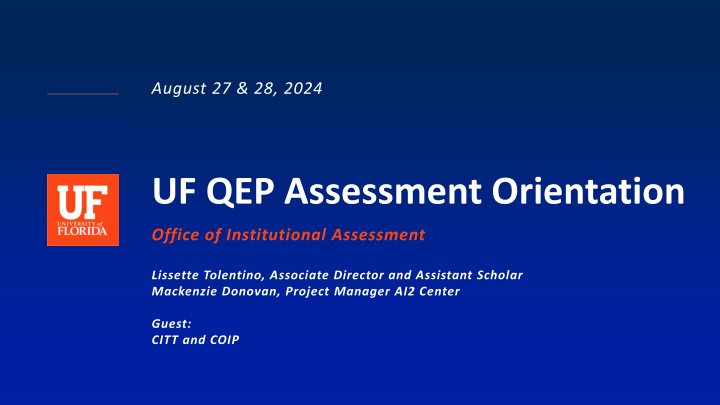
UF QEP Assessment Orientation
The UF Quality Enhancement Plan (QEP) focuses on AI Across the Curriculum, integrating AI concepts, skills, and applications for all students. The QEP Task Force, initiated by the Office of the Provost, developed this comprehensive project to provide students with digital citizenship, global collaboration skills, and foundational AI expertise. Learn about the QEP Brief Overview, Student Learning Outcomes, and the importance of AI integration campus-wide.
Download Presentation

Please find below an Image/Link to download the presentation.
The content on the website is provided AS IS for your information and personal use only. It may not be sold, licensed, or shared on other websites without obtaining consent from the author. If you encounter any issues during the download, it is possible that the publisher has removed the file from their server.
You are allowed to download the files provided on this website for personal or commercial use, subject to the condition that they are used lawfully. All files are the property of their respective owners.
The content on the website is provided AS IS for your information and personal use only. It may not be sold, licensed, or shared on other websites without obtaining consent from the author.
E N D
Presentation Transcript
August 27 & 28, 2024 UF QEP Assessment Orientation Office of Institutional Assessment Lissette Tolentino, Associate Director and Assistant Scholar Mackenzie Donovan, Project Manager AI2 Center Guest: CITT and COIP
Overview of Todays Meeting 1 QEP Brief Overview 2 QEP Assessment 3 AI ACROSS THE CURRICULUM Questions 2
What is the Quality Enhancement Plan (QEP): AI Across the Curriculum? Comprehensive, Institution-Wide Project Inclusive of all students Integrates initiatives with Graduate School, professional colleges, and relevant institutes and centers AI Across the Curriculum Extends AI concepts, skills and applications to all students QEP Brief Overview 3
QEP Brief Overview Quality Enhancement Plan: AI Across the Curriculum Why AI Across the Curriculum? Topic Development: Campus-wide effort initiated at the Office of the Provost QEP Task Force is Formed Two faculty members Co-Chairs (Dr. Kati Migliaccio and Dr. Jane Southworth) Representation (Faculty, administrators, staff, and students) 18 months development of the QEP Dissemination across UF Campus AI Across the Curriculum is designed to: Provide students with the resources and skills to become: digital citizens global collaborators Support students acquisition of: basic awareness general knowledge of AI Allow opportunities for students to: apply and use AI in relevant, discipline-specific ways develop foundational expertise in AI 4
QEP Brief Overview Quality Enhancement Plan: AI Across the Curriculum QEP Student Learning Outcomes AI Literacies (Ng et al. (2021): AI LITERACY CATEGORIES AI DESCRIPTION CONTENT Know the basic functions ofAI and to useAI applications >50% Six SLOs across four artificial intelligence literacies Ng et al. (2021). Assessment of outcomes integrated with UF s annual assessment system: Reporting Evaluation Use of results for improvement Know & Understand AI ApplyingAI knowledge, concepts and applicationsin different scenarios Human-centered considerations (e.g., fairness, accountability, transparency, ethics, safety) Use&Apply AI >50% >50% AI Ethics Higher-order thinking skills (e.g., evaluate, appraise, predict, design) with AI applications Evaluateand CreateAI >50% Support AI through related knowledge and skill development (e.g., programming, statistics) and/or contain a lower totalAI content of one of the four Core AI Literacy topics. 10-49% AI Enabled 5
QEP Brief Overview Quality Enhancement Plan: AI Across the Curriculum QEP Student Learning Outcomes SLO SLO1. Identify, describe, and/or explain the components, requirements, and/or characteristics of AI. SLO2. Identify, describe, define and/or explain applications ofAI in multiple domains. SLO3. Select and/or utilize AI tools and techniques appropriate to a specific context and application. SLO4. Develop, apply, and/or evaluate contextually appropriate ethical frameworks to use across all aspects of AI. SLO5. Assess the context-specific value or quality ofAI tools and applications. SLO6. Conceptualize and/or develop tools, hardware, data, and/or algorithms utilized in AI solutions. 6
Why and How we assess the QEP Goals and SLOs QEP Assessment Why: Institutional Assessment and Effectiveness System Evaluation Processes QEP Goals and SLO Assessment How: QEP Goals and outputs focus on curricular activities SLOs are assessed via a rubric associated with key assessments 7
QEP Assessment The Six SLO Rubrics Achievement Levels Rubric Design Four achievement levels (3) is the Target. (4) exceeds the Target (2) or (1) below the Target Holistic rubric allows autonomy in rating accommodates discipline-specific skills provides actionable data for institutional review and use for improvement 8
QEP Assessment SLO 4 3 (TARGET) 2 1 The Six SLO Rubrics SLO1. Identify, describe, and/or explain the components, requirements, and/or characteristics of AI. The student identifies, describes and/or explains all of the components, requirements, and/or characteristics of AI. The student identifies, describes and/or explains most of the components, requirements, and/or characteristics of AI. The student does not identify, describe and/or explain any of the components, requirements, and characteristics of AI. The student identifies, describes and/or explains a few of the components, requirements, and/or characteristics of AI but does not identify, describe and/or explain many. SLO2. Identify, describe, define and/or explain applications of AI in multiple domains. The student identifies, describes, defines and/or explains all of the applications of AI in multiple domains. The student identifies, describes, defines and/or explains most of the applications of AI in multiple domains. The student does not, identify, describe, define and/or explain any of the applications of AI in multiple domains. The student identifies, describes, defines and/or explains few of the applications of AI in multiple domains but does not identify, describe and/or explain many. SLO3. Select and/or utilize AI tools and techniques appropriate to a specific context and application. The student selects and/or utilizes all of the AI tools and techniques appropriate to a specific context and application. The student selects and/or utilizes most of the AI tools and techniques appropriate to a specific context and application. The student does not select and/or utilize any of the AI tools and techniques appropriate to a specific context and application. The student selects and/or utilizes few of the AI tools and techniques appropriate to a specific context and application but does not select and/or utilize many. The student develops, applies, and/or evaluates a few of the contextually appropriate ethical frameworks to use within AI. The student develops, applies, and/or evaluates all of the contextually appropriate ethical frameworks to use within AI. The student develops, applies, and/or evaluates most of the contextually appropriate ethical frameworks to use within AI. The student does not develop, apply, and/or evaluate any of the contextually appropriate ethical frameworks to use within AI. SLO4. Develop, apply, and/or evaluate contextually appropriate ethical frameworks to use across all aspects of AI. The student assesses all of the context-specific value or quality of AI tools and applications. The student assesses a few of the context-specific value or quality of AI tools and applications. SLO5. Assess the context-specific value or quality of AI tools and applications. The student assesses most of the context- specific value or quality of AI tools and applications. The student does not assess any of the context-specific value or quality of AI tools and applications. SLO6. Conceptualize and/or develop tools, hardware, data, and/or algorithms utilized in AI solutions. The student conceptualizes and/or develops all tools, hardware, data, and/or algorithms utilized in AI solutions. The student conceptualizes and/or develops most of the tools, hardware, data, and/or algorithms utilized in AI solutions. The student conceptualizes and/or develops a few of the tools, hardware, data, and/or algorithms utilized in AI solutions. The student does not conceptualize or develop any of the tools, hardware, data, and/or algorithms utilized in AI solutions. 9
*Note: You can find more details in the QEP AI Assessment Guide and Rubrics document 10
QEP Assessment Process Three-Step Process: Important! Sampling The 20% sample will be provided for each faculty member via e-mail (Password protected file) Random selection: 20% sample (AI designated courses) Faculty choose course assignment and schedule appointment with instructional designers (IDs) to set up the rubrics (Use link: Booking for Outcome Setup) Assignment Selection Faculty identify course assignment(s) to measure AI SLOs AI SLO rubrics: Must be scored using Speed Grader, otherwise data will not be recorded. This is a crucial step! Do not interfere with students grades (IDs set up) IDs assist faculty associating rubrics with assignments Rating Criteria Criteria are assessed at the same time the assignment is graded 11
QEP Assessment Information for Students Choose an assignment in your course Request an appointment with an instructional designer Make sure once rubrics are associated with assignments, the rubrics are completed using Speed Grader How to associate outcome rubrics in Canvas for data collection purposes *Keep in mind that completing the AI SLO Rubrics DOES NOT impact students grades. 12
QEP Assessment Information for Students The additional rubric criteria associated to this assignment serve to gather anonymous data on students performance toward AI student learning outcomes (SLOs). These rubrics reflect the overall expected outcomes for students completing AI courses. The scoring of these criteria does not impact your grade. Suggested Narrative for Syllabi 13
QEP Assessment Additional Resources Videos: Guides: QEP AI Assessment Guide and Rubrics Videos: Step 1: Purpose and Choosing an Assignment (2:00) Step 2: Setting up Outcomes in Canvas (3:31) Step 3: Scoring Outcomes in Canvas (1:34) 14
QEP Assessment Summary Review QEP assessment guide and rubrics Select one or more assignments QEP Faculty Expectations Work with the instructional designer Assess 20% sample selected for the course Complete Rubrics in Speed Grader Provide feedback on the process, so we can modify and improve 15
Contact the Office of Institutional Assessment assessment@aa.ufl.edu Questions? Thank You! 16





